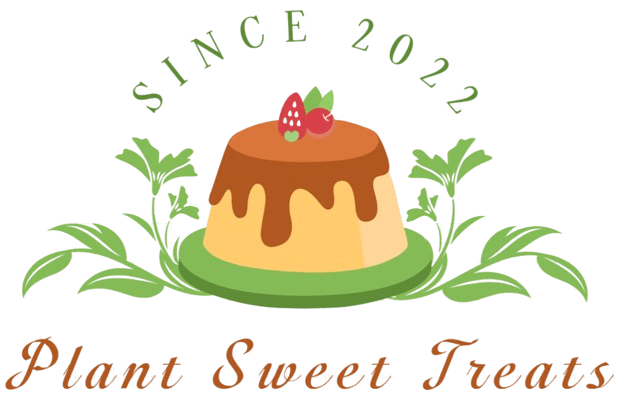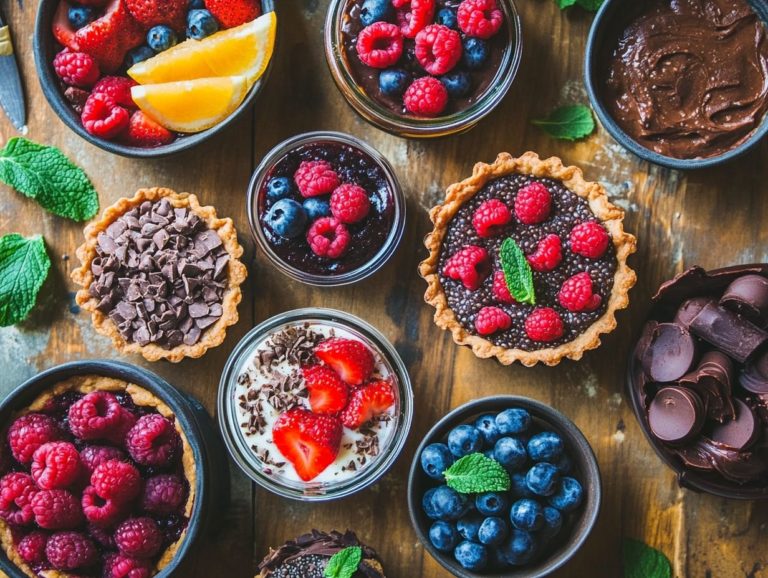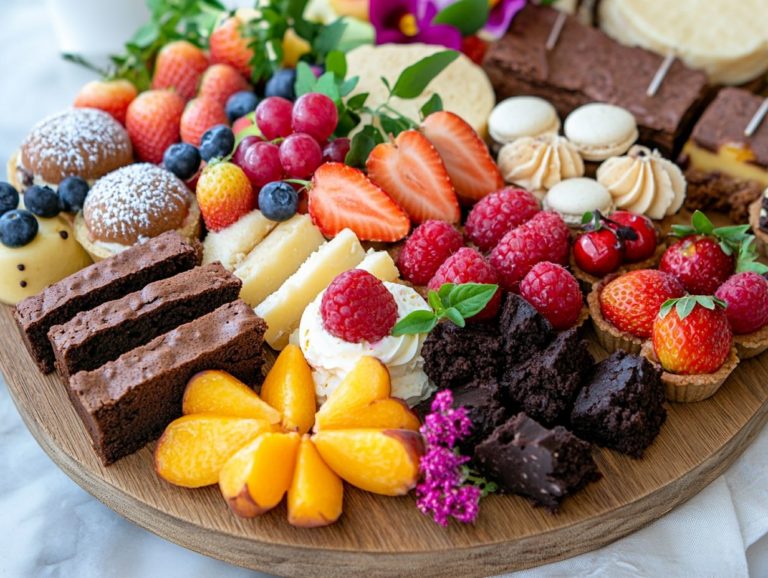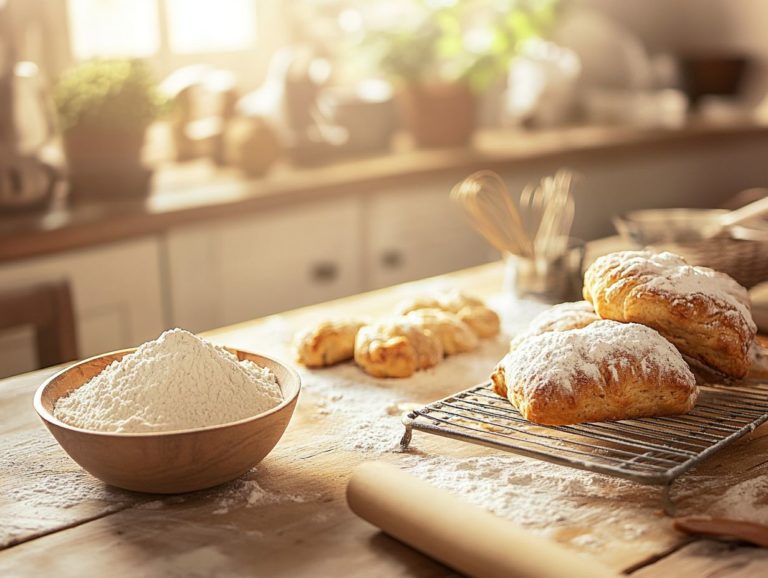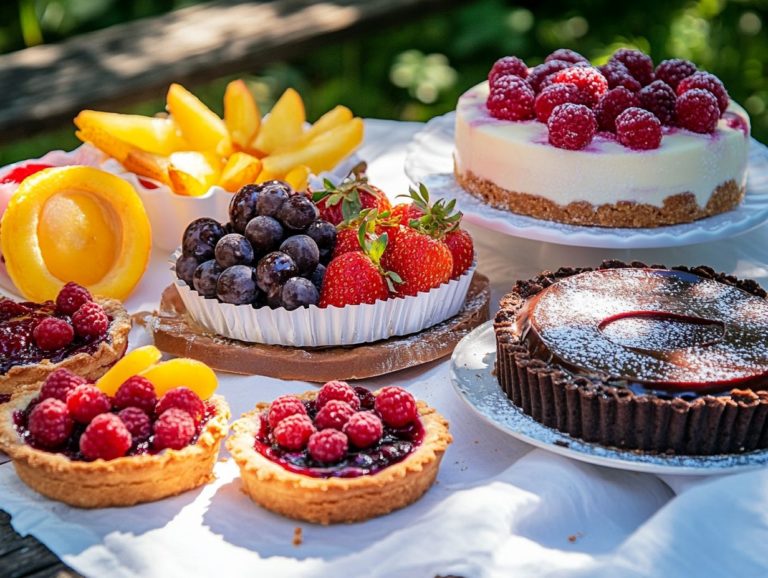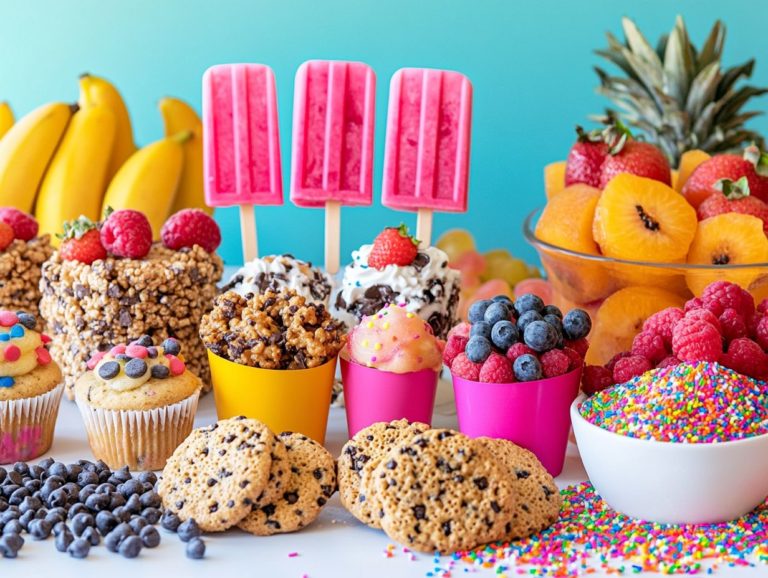A Beginner’s Guide to Gluten-Free Dessert Ingredients
Navigating the realm of gluten-free baking is more than just necessary; it can be a truly delightful adventure, particularly when desserts like gluten-free brownies, cookies, and cakes are involved.
Whether you re modifying recipes to accommodate dietary restrictions or simply venturing into new culinary territories, grasping the fundamentals of common gluten-free ingredients and gluten-free baking methods is crucial.
This guide will familiarize you with an array of gluten-free staples, such as almond flour and coconut sugar, while providing insights on substituting traditional ingredients with their gluten-free alternatives and substitutes.
Get ready to whip up mouthwatering gluten-free treats that everyone will love, following gluten-free diet guidelines!
Contents
- Key Takeaways:
- What Are Common Gluten-Free Dessert Ingredients in a Gluten-Free Pantry?
- 2. Coconut Flour: A Gluten-Free Baking Staple
- 3. Arrowroot Powder
- 4. Xanthan Gum: A Gluten-Free Baking Essential
- 5. Agave Nectar: A Natural Sweetener
- How to Substitute Regular Ingredients with Gluten-Free Alternatives?
- Frequently Asked Questions
- What exactly does it mean for a dessert ingredient to be gluten-free?
- What are some common gluten-free dessert ingredients?
- Are all desserts labeled “gluten-free” safe for those with celiac disease or gluten intolerance?
- Can I substitute gluten-free flours for regular flour in any dessert recipe?
- Are there any gluten-free alternatives to traditional dessert ingredients, such as cookies or cakes?
- Is it necessary to strictly follow a gluten-free diet for all desserts, or are there some exceptions?
Key Takeaways:
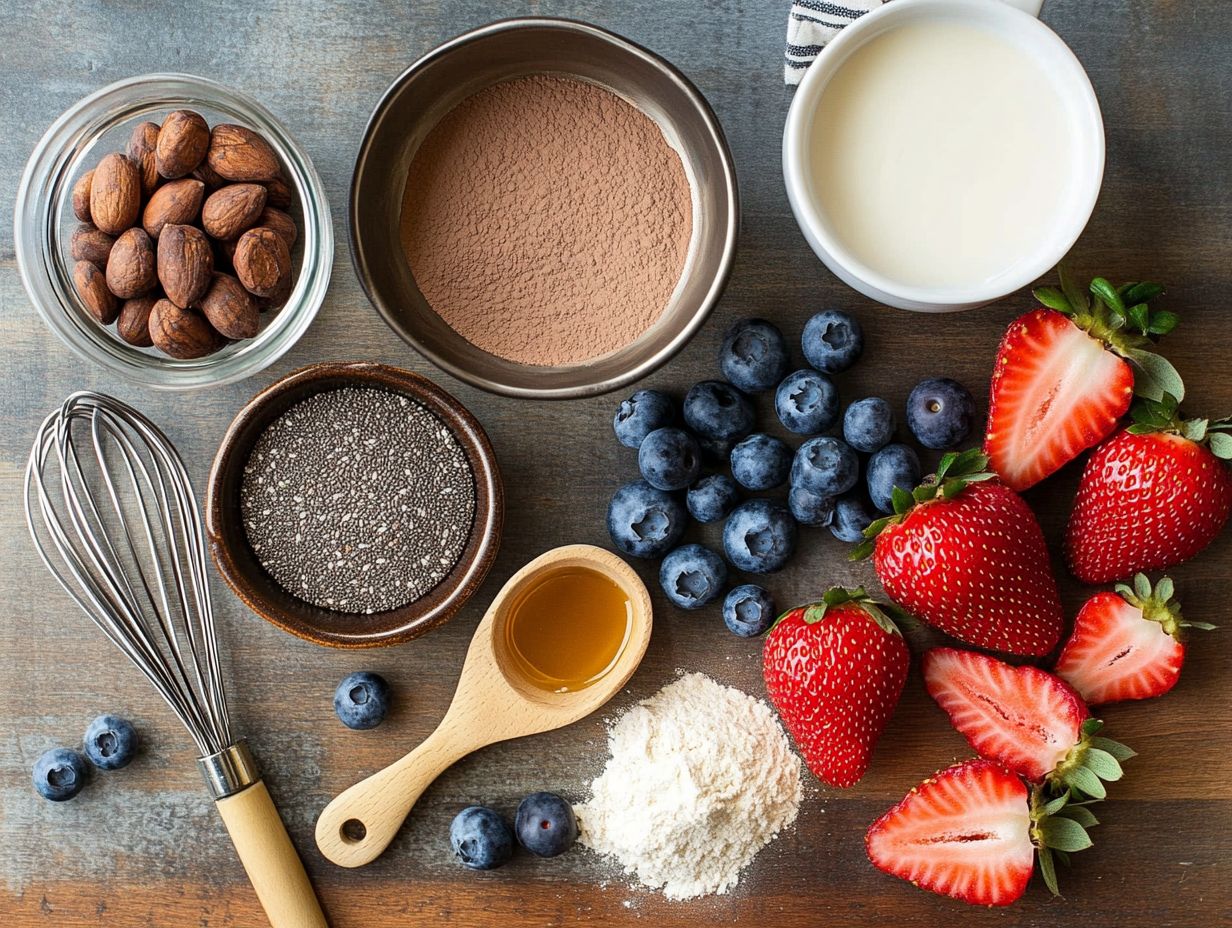
- Experiment with almond, coconut, and arrowroot as gluten-free flour substitutes to add texture and flavor to your desserts, including gluten-free biscuits and other treats.
- Sweeten your treats with natural alternatives like agave nectar, maple syrup, coconut sugar, and dates, instead of processed sugar, aligning with gluten-free nutrition guidelines.
- Get creative with nut butters, fresh fruits, and unsweetened cocoa powder for added depth and richness in your gluten-free desserts and snacks.
What Are Common Gluten-Free Dessert Ingredients in a Gluten-Free Pantry?
When you delve into gluten-free baking, grasping the common gluten-free dessert ingredients is crucial for crafting delightful confections that everyone can savor, particularly those following a gluten-free diet, like individuals with celiac disease or gluten sensitivities.
You ll find staple alternatives such as almond flour, coconut flour, and gluten-free baking mixes are essential for creating a diverse array of treats, including scrumptious gluten-free brownies, cookies, cakes, gluten-free banana bread, and gluten-free chocolate chip cookies.
Ingredients like xanthan gum are vital in achieving the perfect texture and binding properties in gluten-free recipes. Xanthan gum acts as a thickening agent that helps keep gluten-free baked goods from falling apart, allowing you to effortlessly recreate beloved classic desserts without the gluten. Its binding ability ensures your gluten-free dough and mixtures maintain the structure needed for delicious results.
1. Almond Flour in Gluten-Free Baking
Almond flour stands out as a premium gluten-free flour alternative, delivering a delightful nutty flavor while significantly enhancing the nutritional profile of your gluten-free baked goods. If you re following a gluten-free diet, this ingredient is essential for gluten-free cooking and recipes.
Packed with protein, healthy fats, and vitamin E, almond flour is about more than just taste; it actively supports your overall health. Unlike many other gluten-free flours, it boasts impressive binding capabilities, allowing it to perform beautifully in a variety of recipes. This means your cookies, cakes, and breads will maintain their structure and moisture, giving you confidence in your gluten-free baking.
Its versatility makes almond flour a prime choice for creating delectable gluten-free options. Whether you’re whipping up chewy cookies or crafting light, airy cakes, you ll find that almond flour elevates both flavor and texture, transforming your gluten-free desserts into healthier and utterly irresistible treats.
2. Coconut Flour: A Gluten-Free Baking Staple
Coconut flour stands out as an exceptional gluten-free flour option! Its remarkable ability to absorb moisture and high fiber content make it a fantastic choice for gluten-free baking with a healthier twist. This flour is a must-have for any gluten-free pantry.
Coconut flour absorbs a lot of moisture. You will need to adjust your recipes, especially regarding liquid and binding agents. This unique characteristic can elevate the texture of your baked goods, resulting in a light and airy finish that can’t be achieved with grain-based alternatives. For optimal results, consider adding gluten-free baking powder.
To harness the full potential of coconut flour, substitute about 20-30% of the total flour with coconut flour. Increase the liquid by at least an equal amount! Incorporate eggs for necessary structure and moisture, ensuring you achieve the desired consistency in your culinary creations.
3. Arrowroot Powder
Arrowroot powder is your go-to gluten-free ingredient! It s perfect for thickening a variety of desserts while delivering a remarkably smooth texture without relying on gluten-containing thickeners.
This natural starch, extracted from the roots of the arrowroot plant, is especially beneficial for those with gluten sensitivities or celiac disease. It thickens sauces and gravies and elevates the mouthfeel of puddings and custards, transforming each bite into a delightful experience.
When incorporating arrowroot powder into your gluten-free recipes, remember to mix it with cold water before adding it to heated liquids. This prevents clumping and ensures a consistent texture, making it an excellent choice for bakers aiming to craft fluffy gluten-free cakes that are moist and tender!
4. Xanthan Gum: A Gluten-Free Baking Essential
Xanthan gum is an essential ally in your gluten-free baking endeavors! It serves as a binding agent, replicating the elasticity and structure provided by gluten in traditional recipes.
Its inclusion allows your batter or dough to hold together more effectively, banishing that crumbly texture often found in gluten-free products. By mimicking gluten’s characteristics, xanthan gum enhances not only the texture but also the overall mouthfeel of your baked goods. Incorporating xanthan gum into your gluten-free bread and pastries ensures a moist, cohesive crumb, essential for a satisfying eating experience.
For most recipes, a little goes a long way typically, about 1 teaspoon of xanthan gum per cup of gluten-free flour is recommended. If making recipes that demand more elasticity, like pizza dough and gluten-free bread, increase the amount slightly for the perfect consistency!
5. Agave Nectar: A Natural Sweetener
Agave nectar serves as a natural sweetener in your gluten-free desserts! It presents a unique flavor profile and has a lower glycemic index compared to traditional sugars.
Its distinct caramel-like sweetness enhances the taste of your baked goods and pairs beautifully with various ingredients such as chocolate, nuts, and fruits. When substituting agave nectar for sugar, remember that it’s sweeter than granulated sugar, so you ll need less of it. This thoughtful adjustment can lead to a moist and flavorful texture that beautifully complements gluten-free flours, which can sometimes turn out drier.
By incorporating this versatile sweetener, you can craft scrumptious treats that not only satisfy your palate but also adhere to gluten-free guidelines!
6. Maple Syrup: A Gluten-Free Sweetener
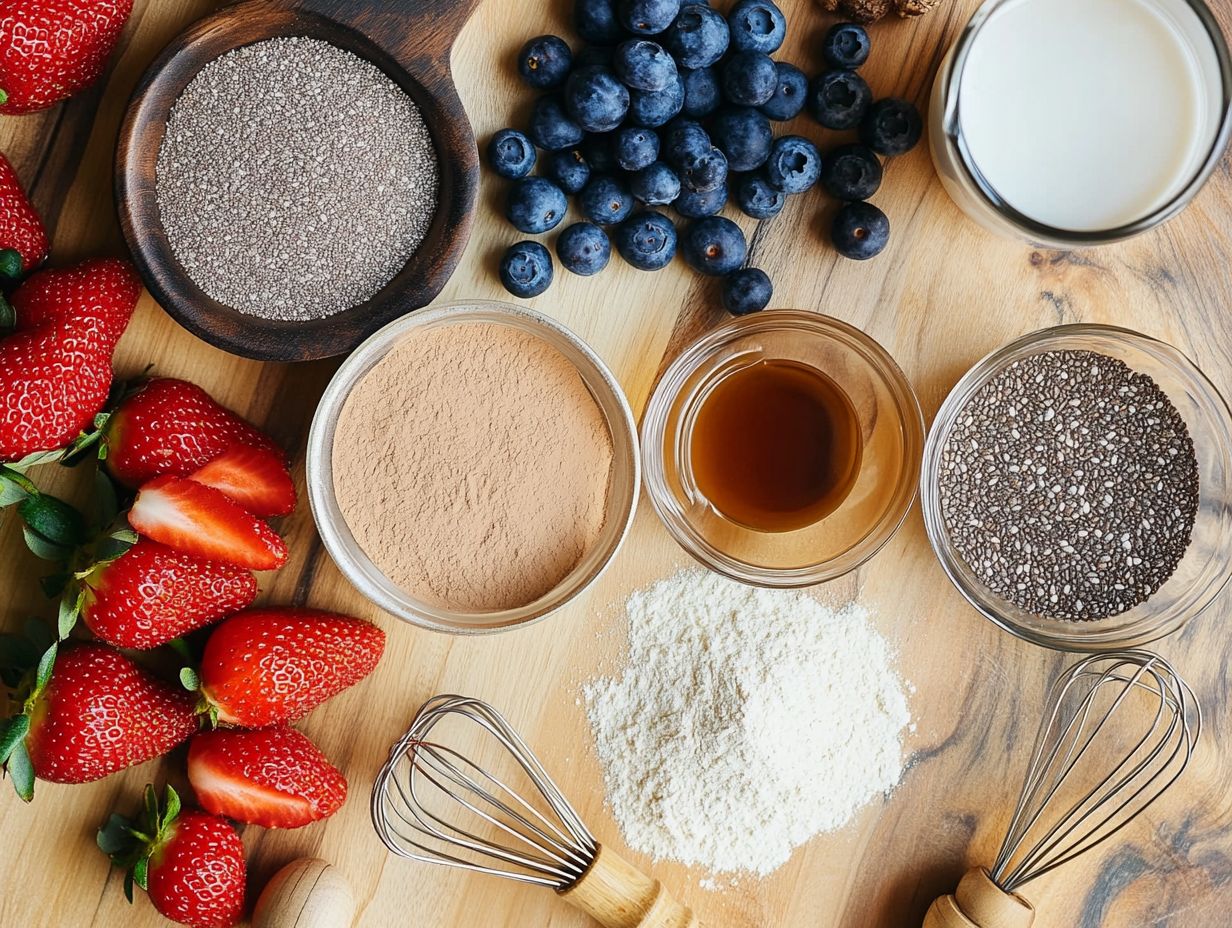
Maple syrup is a beloved natural sweetener that elevates gluten-free desserts with its rich flavor. It also serves as a binding agent in gluten-free recipes, making it ideal for gluten-free blends.
Its unique taste not only enhances sweetness but also beautifully complements various flavors. This makes it an ideal choice for anyone who is gluten-intolerant. Incorporating maple syrup in your baking transforms your creations, turning ordinary gluten-free cakes or brownies into extraordinary delights.
Imagine a moist gluten-free chocolate cake that reaches new heights with just a drizzle of maple syrup in the batter, enriching its chocolatey richness. Using maple syrup in your gluten-free brownies yields a wonderfully fudgy texture, making each bite an indulgent treat.
Whether you incorporate it into cakes, cookies, or even pancake recipes, this natural sweetener brings delightful complexity that appeals to every palate. Your gluten-free options will always be satisfying.
7. Coconut Sugar: A Healthier Gluten-Free Sweetener
Coconut sugar serves as an excellent alternative for those venturing into gluten-free baking. It offers a rich caramel-like flavor and has a lower glycemic index, making it appealing for anyone seeking healthier sweetening options.
Unlike refined sugar, which can send your blood glucose levels on a rollercoaster ride, coconut sugar releases its sweetness gradually into your bloodstream. This promotes stable energy levels and retains some nutrients from the coconut palm, including iron, zinc, and antioxidants, making it a more nutritious option.
If you’re exploring gluten-free desserts, incorporating coconut sugar elevates the flavor profile and aligns with a health-conscious approach to indulgence. Consider trying recipes like:
- Coconut sugar brownies
- Blueberry coconut muffins
These delightful treats allow you to enjoy a sweet moment without compromising your dietary preferences.
8. Dates: A Natural Gluten-Free Sweetener
Dates are a sweet treasure that will elevate your desserts! Celebrated for their natural sweetness and delightful chewy texture, dates are a staple in gluten-free baking. They are perfect for sweetening and adding moisture to your favorite desserts.
Not only do they elevate flavors, but they also act as an exceptional base ingredient that binds other components. This makes them a versatile choice in a range of gluten-free recipes. For example, you could easily create a batch of energy bites by blending dates with nuts and seeds. This results in a nutritious snack that satisfies your sweet cravings.
Dates are also fantastic in gluten-free apple pie and other gluten-free desserts. You can transform dates into a luscious date caramel sauce or incorporate them into raw desserts, like no-bake chocolate brownies, where they contribute depth and richness without the need for flour.
With this remarkable fruit, you can effortlessly explore a multitude of delightful gluten-free treats and gluten-free snacks.
9. Unsweetened Cocoa Powder
Unsweetened cocoa powder is an essential ingredient in your gluten-free baking repertoire, delivering a rich chocolate flavor without added sugars or gluten.
This versatile gem not only elevates taste but also acts as a natural thickener and color enhancer in your culinary creations. When you incorporate cocoa powder into cakes, brownies, and cookies, it adds depth and complexity to the flavor profile.
This enables you, as a gluten-free baker, to craft indulgent treats that everyone can savor, especially in gluten-free chocolate and gluten-free brownies. It pairs beautifully with alternative flours, ensuring a balanced texture that rivals traditional baked goods.
By integrating it into your batters and mixtures, you can transform simple ingredients into irresistible chocolate delights that satisfy cravings while adhering to gluten-free dietary needs.
10. Dark Chocolate Chips
Dark chocolate chips bring a rich flavor to your gluten-free desserts, making them a standout choice for cookies, brownies, and an array of other sweet delights.
These decadent morsels not only enhance the flavor but also contribute a satisfying texture that beautifully complements various gluten-free ingredients. When you incorporate them into your baking, they melt to perfection, creating luscious pockets of gooey chocolate that enhance the entire eating experience.
Imagine preparing a batch of gluten-free chocolate chip cookies, where these chips are gently folded into a blend of almond flour and eggs, resulting in a chewy masterpiece. Or picture gluten-free brownies, where dark chocolate chips can amplify the chocolate flavor while ensuring a fudgy texture that is simply irresistible.
Integrating dark chocolate chips into your gluten-free recipes adds an indulgent twist that will delight both gluten-free enthusiasts and traditional dessert lovers alike.
11. Nut Butters
Nut butters, like almond or peanut butter, are your secret weapons in the gluten-free baking arena. They add a delightful creaminess and richness to your baked goods while providing a healthy dose of fats.
When you incorporate these nut butters, you’re not just enhancing the flavor; you re also significantly boosting the nutritional profile of your recipes. Packed with protein, vitamins, and minerals, these nut butters stand as excellent alternatives to traditional fats like butter or oils.
They can elevate the texture of your gluten-free desserts, making them irresistibly moist and satisfying. What s more, the natural sweetness of nut butters can help you cut back on added sugars, allowing you to create healthier treats without compromising on flavor.
By embracing nut butters, you’re not just baking; you’re indulging in a deliciously nutritious experience that elevates your gluten-free creations to new heights!
12. Fresh Fruits
Fresh fruits aren t just a treat for your taste buds; they also act as natural sweeteners and flavor enhancers in gluten-free baking, making them an essential ingredient in a variety of gluten-free desserts.
Imagine the vibrant burst of blueberries and strawberries or the tropical charm of mangoes and pineapples these fruits introduce a delightful range of flavors and a wealth of nutrition to your culinary creations.
Not only do they provide moisture and richness to gluten-free cakes and muffins, but they also pack each bite with vitamins and antioxidants that promote your overall health. Think about incorporating mashed bananas into your gluten-free bread for a naturally sweet touch.
Add zesty lemon or orange zest to elevate your dessert with a refreshing brightness. For snacking, consider fruit-filled energy balls or muffins brimming with juicy peaches, showcasing the versatility and benefits of these colorful, wholesome ingredients.
How to Substitute Regular Ingredients with Gluten-Free Alternatives?
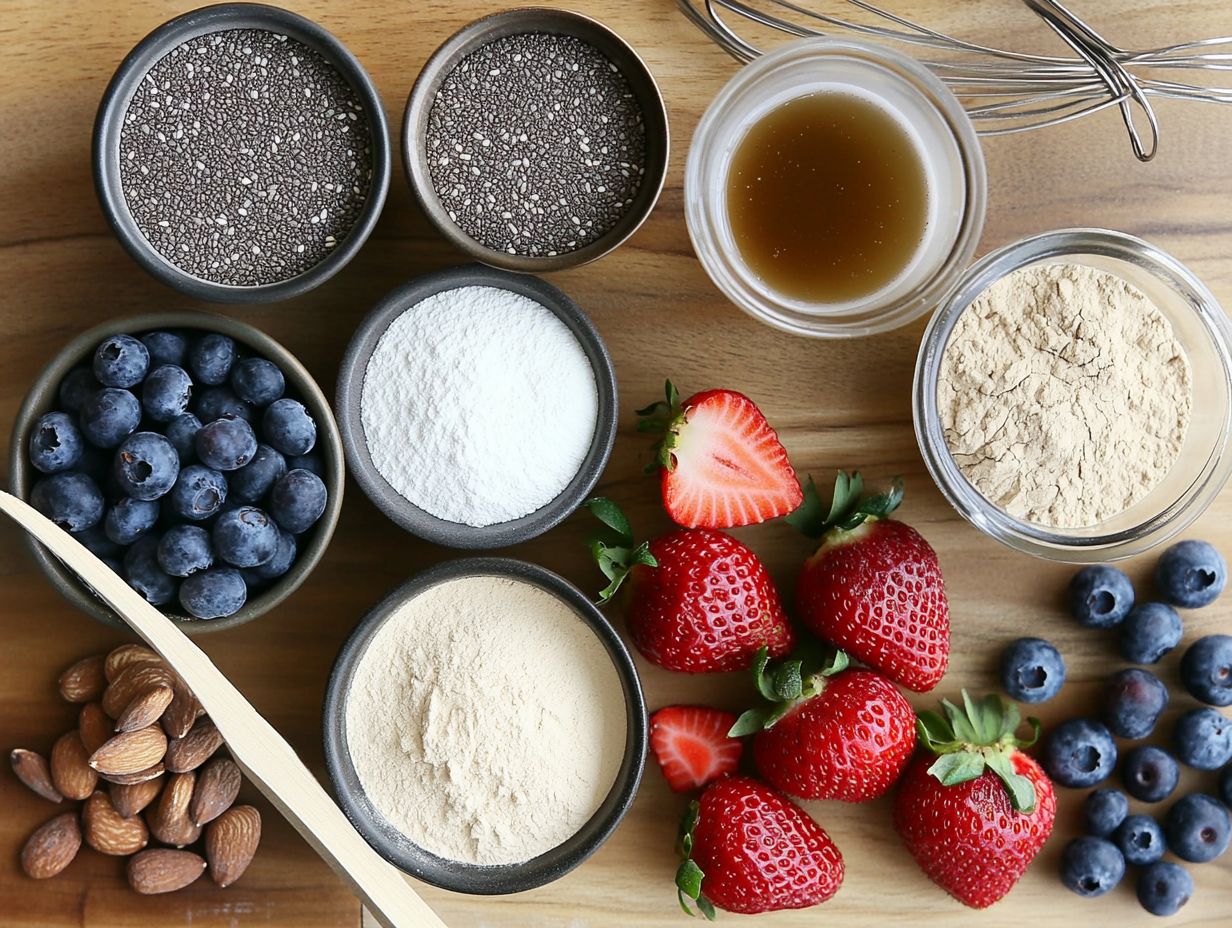
Substituting regular ingredients with gluten-free alternatives may initially appear overwhelming, but with the right guidance, it becomes a seamless journey that unlocks a realm of gluten-free baking possibilities, ranging from artisanal breads to delectable cakes and cookies.
Get ready to master replacing all-purpose flour with gluten-free flour blends or utilizing gluten-free baking mixes, which is crucial for achieving the perfect texture and flavor in your beloved recipes.
Don t overlook the importance of thoughtful substitutions for sugar, fat, and flavorings to elevate your gluten-free creations to new heights!
1. Flour Substitutions
Flour substitutions are foundational in the realm of gluten-free baking, and selecting the right gluten-free flour blend can profoundly influence the texture and flavor of your creations.
With a plethora of options at your disposal, you can delve into choices like almond flour, which lends a rich, nutty flavor and a wonderfully moist texture, or coconut flour, known for its subtle sweetness and impressive fiber content. It’s crucial to recognize that each gluten-free flour possesses distinct characteristics, and combining them often yields the most satisfying results.
For example, utilizing a gluten-free baking mix can streamline your baking experience, while a blend of almond and coconut flours can elevate both flavor and structure, making the process of creating gluten-free bread and gluten-free cake much easier.
By experimenting with different ratios and varieties, you can craft personalized recipes that cater to your unique tastes and dietary preferences, perfecting your gluten-free blends and gluten-free formulations.
2. Sugar Substitutions
When you re looking to replace sugar in your gluten-free baking, it s essential to select alternatives that not only offer sweetness but also enhance the other flavors and textures in your desserts.
Take agave nectar, for example; its liquid sweetness blends effortlessly into batters and doughs, making it a stellar choice for creating moist cakes and cookies. Then there s maple syrup, which boasts a rich flavor profile that can elevate the depth of baked goods like muffins and pancakes, resulting in a truly unique taste experience.
Coconut sugar is another fantastic option. Sourced from the sap of coconut palm trees, it imparts a slight caramel note and can be substituted cup for cup in many recipes. Each of these substitutes not only contributes sweetness but also enriches the overall flavor and health benefits of your gluten-free treats, allowing for a more delightful indulgence.
3. Fat Substitutions
Fat substitutions in gluten-free baking can elevate the flavor and moisture of your desserts, offering a delightful range of options tailored to your dietary preferences and palate.
Consider exploring alternatives like creamy nut butters; they not only introduce healthy fats but also add a delightful nuttiness to your recipes. Oils such as coconut or avocado are superb choices as well, providing a light texture while enriching the overall profile of your baked goods. If you prefer dairy-free options, using plant-based spreads or dairy-free yogurt can help you achieve a similar consistency without compromising moisture.
When you adjust recipes, it s crucial to consider the unique properties of these substitutes, as they can influence both the texture and baking time. By experimenting with these alternatives, you can craft gluten-free desserts that are not only scrumptious but also perfectly aligned with your dietary needs.
4. Egg Substitutions
Egg substitutions are vital for achieving the perfect texture in gluten-free baking, particularly for those navigating egg allergies or specific dietary restrictions.
By familiarizing yourself with various substitutes like flaxseed meal, chia seeds, and commercial egg replacers, you can effectively maintain moisture and binding even without eggs. For example, mixing flaxseed meal with water creates a gel-like consistency that mimics the role of an egg, making it an excellent choice for muffins and pancakes. Similarly, when chia seeds are combined with liquid, they provide the same binding function while also being a rich source of omega-3 fatty acids.
Commercial egg replacers are tailored specifically for baking, offering you convenience and simplicity as you embrace a gluten-free lifestyle without compromising on flavor or texture.
5. Milk Substitutions
Substituting milk in gluten-free baking is a straightforward endeavor, thanks to the plethora of dairy-free alternatives available that can effortlessly take the place of traditional milk without sacrificing flavor.
Among the most popular choices are almond milk and coconut milk. Almond milk, with its light and slightly nutty taste, can enhance the deliciousness of cakes and cookies. Coconut milk brings a rich creaminess, making it a go-to for baked goods that crave a tropical twist. On the other hand, soy milk offers a more neutral flavor, providing versatility across a range of gluten-free pastries.
When choosing the perfect dairy-free milk for your gluten-free baking, consider how it harmonizes with the overall dish, ensuring that the desired flavors and textures truly shine through.
6. Flavorings and Extracts
Flavorings and extracts are essential in gluten-free baking, elevating the taste of your desserts and allowing you to customize flavors to your liking. Dive into experimenting with different gluten-free flavorings to discover your perfect combination!
Incorporating familiar flavorings, like vanilla extract and almond extract, along with a selection of spices such as cinnamon or nutmeg, can dramatically enhance the flavor profile of your dishes. Imagine adding a splash of vanilla extract to round out the sweetness in your cakes and cookies, or using almond extract to infuse a delightful nutty aroma that beautifully complements gluten-free chocolate desserts.
Spices can be seamlessly integrated into your batters and doughs. Just a teaspoon of cinnamon can elevate a simple gluten-free apple pie into a delicious dish. To truly harness their potential, experiment with different quantities and combinations each addition has the power to impart a unique twist to your gluten-free creations.
Frequently Asked Questions
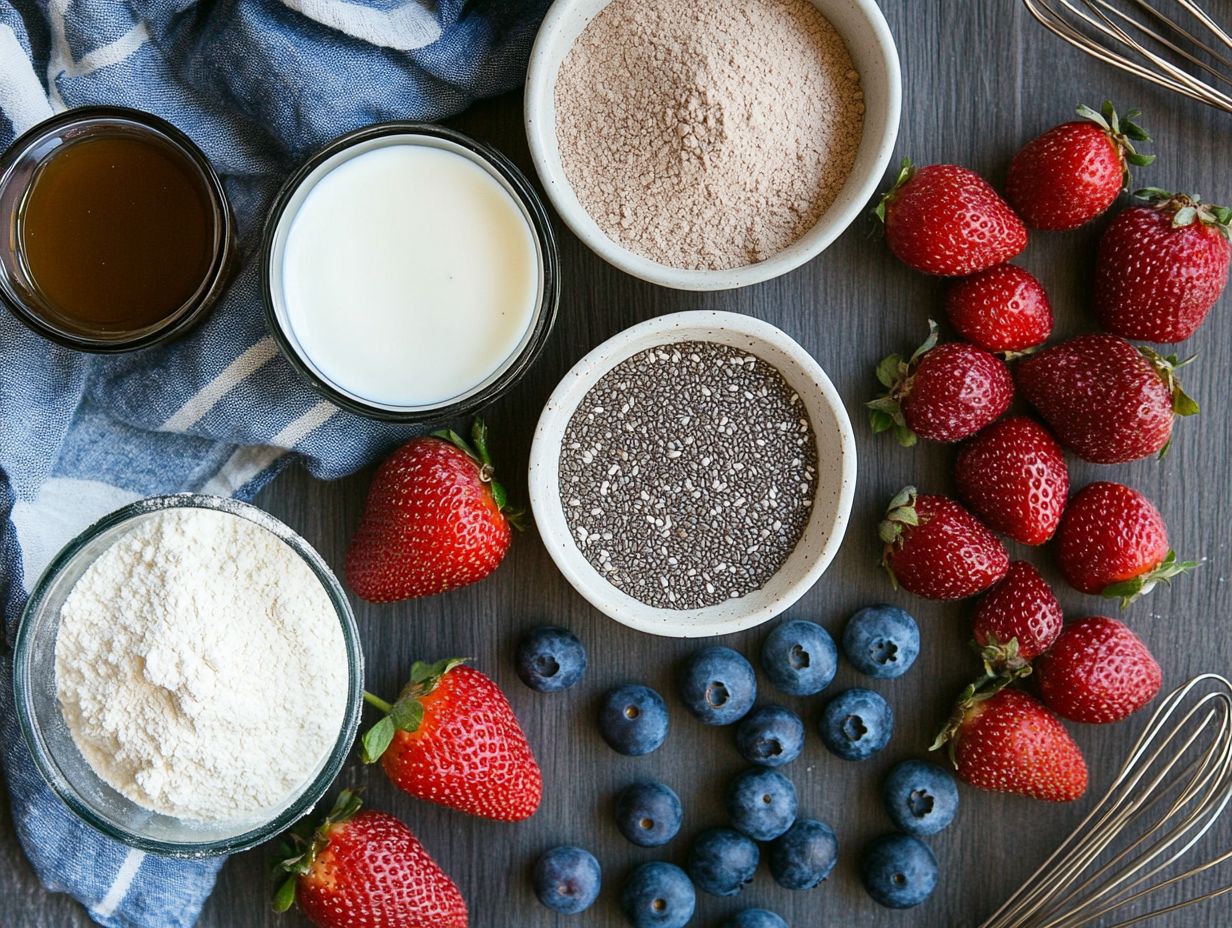
What exactly does it mean for a dessert ingredient to be gluten-free?
Gluten-free dessert ingredients are those that do not contain any gluten, which is a protein found in wheat, barley, and rye. Using gluten-free flours and other gluten-free ingredients ensures that your desserts are safe for those with celiac disease or gluten intolerance.
What are some common gluten-free dessert ingredients?
Some common gluten-free dessert ingredients include almond flour, coconut flour, oat flour, tapioca flour, and gluten-free all-purpose flour blends. Fruits, nuts, and chocolate are also typically gluten-free.
Using a variety of gluten-free flours, such as buckwheat flour and tapioca starch, can help achieve the desired texture and flavor in your gluten-free baking. These gluten-free choices offer unique characteristics that can enhance your recipes.
Are all desserts labeled “gluten-free” safe for those with celiac disease or gluten intolerance?
No, not all desserts labeled “gluten-free” are safe for individuals with celiac disease or gluten intolerance. It is important to read the ingredient list carefully and look for any potential sources of gluten, such as wheat or barley derivatives.
Checking for gluten-free certifications can also help ensure the product meets gluten-free standards. It’s wise to ensure the product has been tested and meets gluten-free standards.
In summary, by experimenting with the ingredients and techniques discussed, you can create delicious gluten-free baked goods that everyone can enjoy!
Can I substitute gluten-free flours for regular flour in any dessert recipe?
It is possible to substitute gluten-free flours for regular flour in most dessert recipes, but it may require some experimentation to achieve the desired texture and taste.
Using a gluten-free flour blend, such as King Arthur flour or a homemade mix, can help achieve the best baking results. These blends are formulated to provide the right balance of gluten-free flours for successful baking.
Gluten-free baking methods and techniques can help you perfect your recipes. It is also important to consider the ratio of wet to dry ingredients and adjust accordingly.
Utilizing gluten-free flour blends can offer better results due to their balanced mixtures of different gluten-free flours.
Yes, there are many gluten-free alternatives to traditional dessert ingredients. Gluten-free products, such as gluten-free cookies and crackers, can be used as bases for your desserts.
These gluten-free substitutes can help you create delicious and safe desserts!
For example, you can use gluten-free cookies or crackers as a base for crusts, or use gluten-free bread or muffins as a base for bread pudding or French toast.
Finding gluten-free products is easier than ever!
Is it necessary to strictly follow a gluten-free diet for all desserts, or are there some exceptions?
It is important for individuals with celiac disease, an autoimmune disorder triggered by gluten, or gluten intolerance to strictly follow a gluten-free diet.
Following gluten-free diet guidelines can ensure that all your meals, including desserts, are safe and enjoyable.
However, those who are simply trying to reduce their gluten intake may be able to enjoy desserts with small amounts of gluten, such as those made with oats or gluten-free all-purpose flour blends.
Following these guidelines can help ensure that your desserts are safe and enjoyable for everyone.
